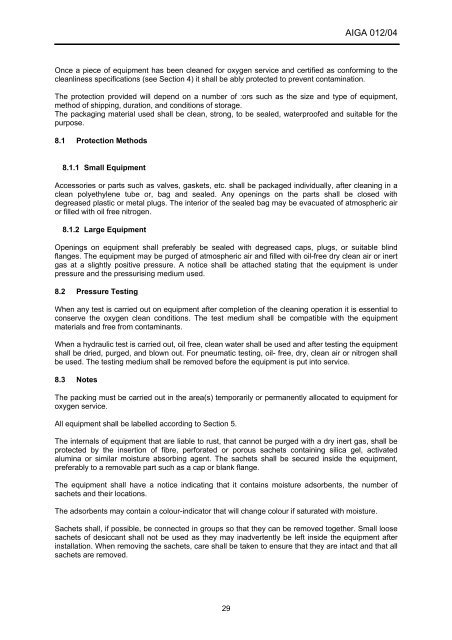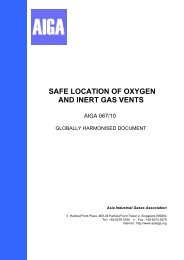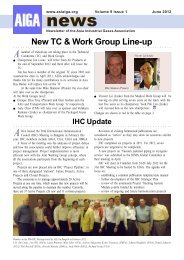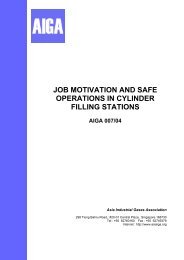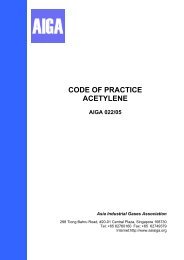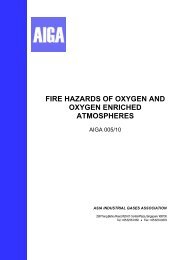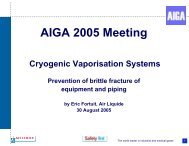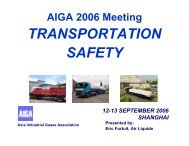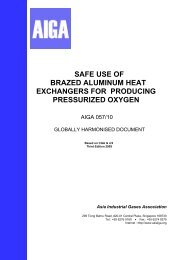CLEANING OF EQUIPMENT FOR OXYGEN SERVICE - AIGA
CLEANING OF EQUIPMENT FOR OXYGEN SERVICE - AIGA
CLEANING OF EQUIPMENT FOR OXYGEN SERVICE - AIGA
Create successful ePaper yourself
Turn your PDF publications into a flip-book with our unique Google optimized e-Paper software.
29<br />
<strong>AIGA</strong> 012/04<br />
Once a piece of equipment has been cleaned for oxygen service and certified as conforming to the<br />
cleanliness specifications (see Section 4) it shall be ably protected to prevent contamination.<br />
The protection provided will depend on a number of :ors such as the size and type of equipment,<br />
method of shipping, duration, and conditions of storage.<br />
The packaging material used shall be clean, strong, to be sealed, waterproofed and suitable for the<br />
purpose.<br />
8.1 Protection Methods<br />
8.1.1 Small Equipment<br />
Accessories or parts such as valves, gaskets, etc. shall be packaged individually, after cleaning in a<br />
clean polyethylene tube or, bag and sealed. Any openings on the parts shall be closed with<br />
degreased plastic or metal plugs. The interior of the sealed bag may be evacuated of atmospheric air<br />
or filled with oil free nitrogen.<br />
8.1.2 Large Equipment<br />
Openings on equipment shall preferably be sealed with degreased caps, plugs, or suitable blind<br />
flanges. The equipment may be purged of atmospheric air and filled with oil-free dry clean air or inert<br />
gas at a slightly positive pressure. A notice shall be attached stating that the equipment is under<br />
pressure and the pressurising medium used.<br />
8.2 Pressure Testing<br />
When any test is carried out on equipment after completion of the cleaning operation it is essential to<br />
conserve the oxygen clean conditions. The test medium shall be compatible with the equipment<br />
materials and free from contaminants.<br />
When a hydraulic test is carried out, oil free, clean water shall be used and after testing the equipment<br />
shall be dried, purged, and blown out. For pneumatic testing, oil- free, dry, clean air or nitrogen shall<br />
be used. The testing medium shall be removed before the equipment is put into service.<br />
8.3 Notes<br />
The packing must be carried out in the area(s) temporarily or permanently allocated to equipment for<br />
oxygen service.<br />
All equipment shall be labelled according to Section 5.<br />
The internals of equipment that are liable to rust, that cannot be purged with a dry inert gas, shall be<br />
protected by the insertion of fibre, perforated or porous sachets containing silica gel, activated<br />
alumina or similar moisture absorbing agent. The sachets shall be secured inside the equipment,<br />
preferably to a removable part such as a cap or blank flange.<br />
The equipment shall have a notice indicating that it contains moisture adsorbents, the number of<br />
sachets and their locations.<br />
The adsorbents may contain a colour-indicator that will change colour if saturated with moisture.<br />
Sachets shall, if possible, be connected in groups so that they can be removed together. Small loose<br />
sachets of desiccant shall not be used as they may inadvertently be left inside the equipment after<br />
installation. When removing the sachets, care shall be taken to ensure that they are intact and that all<br />
sachets are removed.


